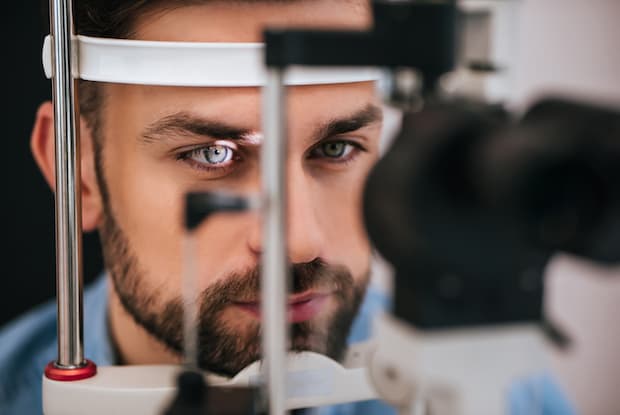Table of Contents
Understanding Glaucoma
Glaucoma is a group of eye disorders that result in progressive eye damage. Glaucoma affects the optic nerve that connects the eye to the brain, leading to vision loss and blindness. Glaucoma is a leading cause of blindness in the United States. In the most common forms of glaucoma (primary open-angle glaucoma and acute angle-closure glaucoma), pressure in the eye increases and causes the optic nerve bundle to malfunction, resulting in issues with the visual signals that reach the brain.
Symptoms of glaucoma can vary depending on your type of glaucoma, but some common symptoms can include:
- Patchy blind spots in your peripheral vision
- Tunnel vision
- Eye pain
- Blurred vision
- Eye redness
- Severe headache
- Halos around lights [1]
The exact cause of glaucoma is unknown, but several risk factors can increase the likelihood of developing this eye condition. In general, medicated solutions like Lumigan eye drops can help reduce symptoms of glaucoma. Risk factors can vary depending on the type of glaucoma. The most common types include normal-tension, open-angle, and angle-closure. Read on to learn more about risk factors that can increase your chance of developing glaucoma. [1] Your risk of developing glaucoma increases significantly if you have previously experienced eye problems or surgery. Glaucoma runs in families, so it is essential to examine your family’s medical history to examine your risk of developing glaucoma. It is essential to tell your eye doctor about your family medical history so they can look out for any warning signs. If you have a family history of intraocular eye pressure, you are at risk of developing glaucoma. Elevated eye pressure occurs due to a buildup of fluid (aqueous humor) that flows through the inside of the eye. In a properly functioning eye, this fluid is supposed to drain through the tissue (trabecular meshwork) at the angle where the iris and cornea meet. When this system is not working properly, eye pressure increases. [2] Other eye problems like chronic dry eyes may also increase your risk of developing glaucoma. Dry eye syndrome and glaucoma often occur together. Symptoms of dry eye syndrome often include tearing sensations in the eye, fluctuating vision, and eyes that feel like sand. Some studies suggest that 40-50 percent of glaucoma patients have dry eye syndrome. [3] Dry eye syndrome can be caused by an inflammation of the eyelids, previous eye infections, using glaucoma eye drops, and activities that reduce blinking like computer use and prolonged reading. If you feel like you are experiencing bothersome dry eye problems, talk to your doctor. In general, people associate glaucoma with older adults. Those over 40 years old are at higher risk of glaucoma, but it can occur at any age. Increased age is a big risk factor because glaucoma is a degenerative disease. The eyes break down with age just as much as other body functions. Because of this, the progression of glaucoma increases significantly with age. In the case of primary open-angle glaucoma, the optic nerve degenerates. The optic nerve is formed by axons (cables) of the retinal ganglion cells that live in the retina. These axons extend into areas of the brain, but if these connections start to degrade, then vision changes can occur. An older optic nerve is not as equipped to deal with issues like increased eye pressure. As the eye ages, the pathway through which fluid flows out of the eye can weaken. [4] In the case of primary angle-closure glaucoma, the lens can begin to thicken as a person gets older. A thickened lens can create the closure of the anterior chamber angle of the eye. This angle is vital to the structure of the eye. If the angle is closed off, the trabecular meshwork that allows fluid to flow through the eye is affected, resulting in increased eye pressure and eventually, vision loss. [5] Diabetes is a complex disease that can affect several functions of your body. Diabetes is a condition in which the body cannot produce insulin (a hormone that takes sugar out of the blood to create energy). If your body cannot produce an adequate amount of insulin, there is too much sugar in the blood, and insulin treatments are needed. Over 29 million Americans have diabetes, most commonly adult-onset diabetes. This type typically occurs over 40 years old and is generally a result of a sedentary lifestyle and an unhealthy diet. [6] There are many complications of diabetes, including diabetic eye disease. Diabetic eye disease includes several eye problems, including glaucoma. Those with diabetes are twice as likely to develop glaucoma as those without diabetes. Open-angle glaucoma is most typically associated with diabetes, as well as neovascular glaucoma in rarer cases. Neovascular glaucoma occurs when new blood vessels grow on the iris and close off the fluid flow, resulting in increased eye pressure. This type of glaucoma can be challenging to treat, and laser surgery is usually required to reduce the buildup of abnormal blood vessels on the iris. Since eye complications are common in diabetes patients, it is vital to keep up with your eye health and get your eyes examined regularly. [6] Cardiovascular disease can wreak havoc on many parts of your body, including your eyes. Cardiovascular disease can involve several conditions: heart disease, heart attack, stroke, heart valve problems, arrhythmia, and heart failure. [7] Several studies show that cardiovascular disease is a major risk factor in the rapid progression of glaucoma. According to researchers, cardiovascular disease has been shown to increase intraocular pressure (IOP) regardless of a history of eye pressure problems. According to the American Academy of Ophthalmology, researchers suggest that there are links between carotid (arteries of the heart) diseases and eye disease. If atherosclerosis (fatty deposits in the heart arteries) are present, then cholesterol may also build up in the retina. If you experience cardiovascular problems, then blood flow and oxygenation of the blood can cause vessels of the eyes to widen or narrow. [8] Anyone can experience glaucoma, but it is much more common in certain ethnic groups. Americans of African and Latin descent are 3 to 4 times more likely to develop glaucoma than those of European ancestry. Primary open-angle glaucoma is the leading cause of irreversible blindness among this population. [8] Also, those of eastern Asian descent experience the highest rate of blindness due to primary angle-closure glaucoma and normal-tension glaucoma. Researchers believe that these patterns are due to genetic predispositions and eye structure. In the case of patients of Asian descent, the iris attaches to the sclera (the eyes white, protective covering) in a way that forms a narrower angle, which leaves the trabecular meshwork exposed. When this occurs, the iris blocks the meshwork and increases eye pressure occurs. [8] Japanese populations also have a much higher incidence of normal-tension glaucoma. Normal-tension glaucoma is a form of glaucoma in which the optic nerve is damaged without the presence of elevated eye pressure. One Japanese study found that normal-tension glaucoma was responsible for 92 percent of open-angle glaucoma cases in Japan. Your doctor can examine the angle of your iris to check if you are at risk for these eye conditions. [9] The content in this article is intended for informational purposes only. This website does not provide medical advice. In all circumstances, you should always seek the advice of your physician and/or other qualified health professionals(s) for drug, medical condition, or treatment advice. The content provided on this website is not a substitute for professional medical advice, diagnosis or treatment.
Prior Eye Conditions
Age

Diabetes
Cardiovascular Disease

Ethnicity
